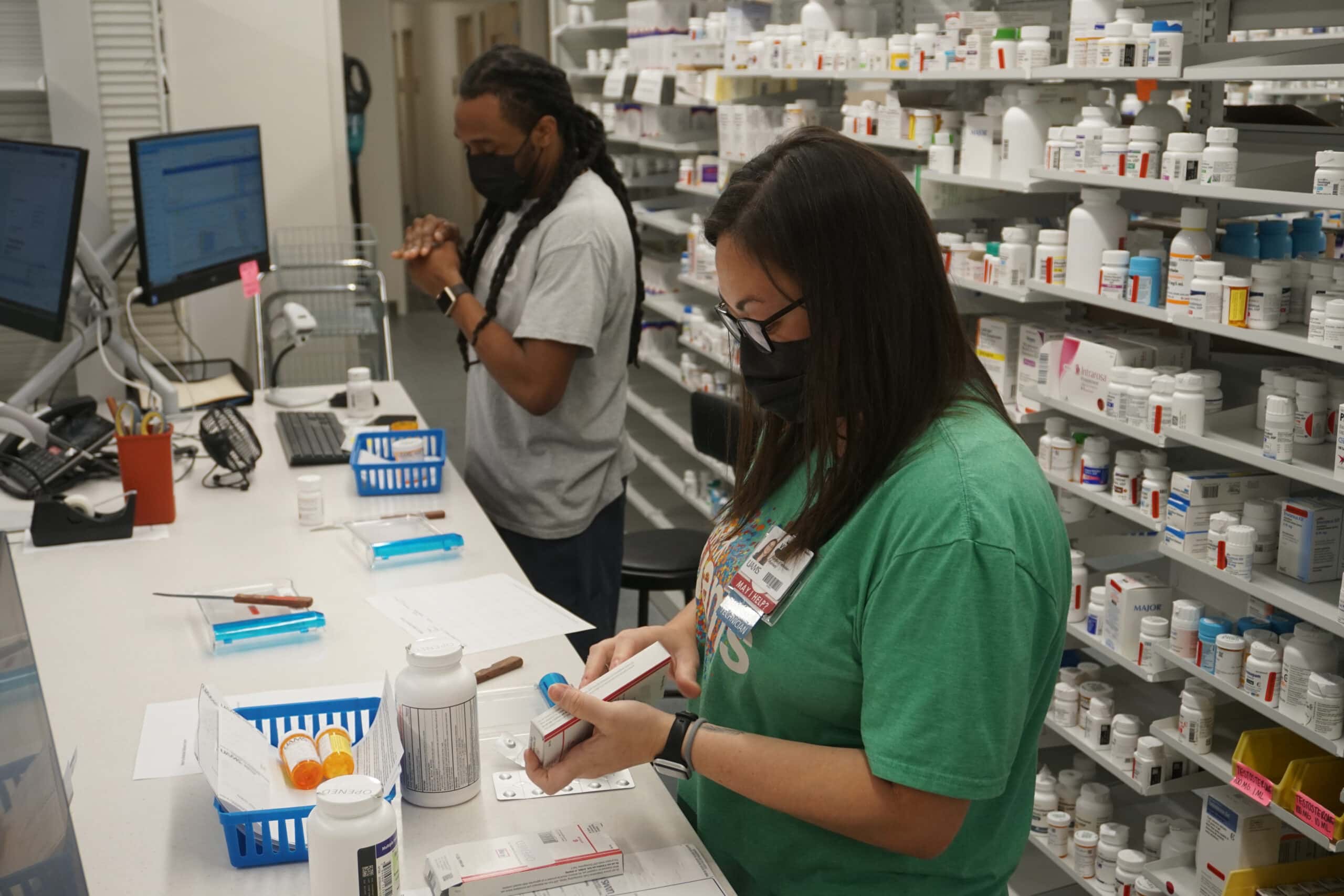View Larger Image

Vickie Gold, foreground, and Travis Staggers fill prescriptions at the UAMS Outpatient Pharmacy in mid-September. UAMS' recent resource optimization efforts saw $6.5 million in savings in pharmacy alone.
Image by Benjamin Waldrum
UAMS Ramping Up ‘Resource Optimization’ Efforts for Fiscal Year 2023
| In response to rapid inflation and increased patient care expenses, the University of Arkansas for Medical Sciences (UAMS) is expanding a successful savings initiative to find $85 million in savings for fiscal year 2023.
UAMS has returned to pre-pandemic levels of surgeries and patient visits and is meeting expectations for clinical revenues, grants and contracts. However, staffing, record inflation and supply chain issues have increased expenses across the board. Expenses for some patient services, for example, are as much as 30% higher than they were.
Pharmaceutical and medical supplies, as well as contract labor, all cost more. Reimbursement rates from both governmental and commercial health care insurance programs have not adjusted for inflation, leaving a sizable gap that hospitals like UAMS are forced to cover.
As with any family faced with a sudden financial change, UAMS has begun to tighten its financial belt and ramp up efforts at what it calls “resource optimization.” Leading the initiative are Amanda George, CPA, UAMS vice chancellor for finance and chief financial officer, and Holly Naramore, project manager.
“Resource optimization is a coordinated effort to improve UAMS’s financial picture,” George said. “We’re doing this to make sure we hit our strategic priorities, including raising compensation. COVID-19 has put some things on hold, but thanks to our re-op efforts we’ve been saving money in spite of it.”
The so-called “re-op” initiative, begun prior to the pandemic, is in line with UAMS’s Vision 2029 strategic plan. The initiative has reduced costs by at least $10 million over each of the past three fiscal years, saving $12.1 million in 2020 and $10.5 million in 2021. This past fiscal year saw $11.5 million in savings. An additional $5 million in annual savings comes from the recently completed electrical power plant on the east side of the Little Rock campus.
Budgets for academic health institutions like UAMS are already strictly controlled, but resource optimization takes things a step further, using a campuswide committee, chaired by George, to identify new and innovative ways to reduce expenses and increase efficiency.
This means looking at every possible avenue to reduce expenses through various projects, including renegotiating contracts and leases as well as optimizing the length of hospital stays and reducing readmissions. Each project is reexamined on a monthly basis to ensure the greatest savings possible.
By far the largest amount saved this past fiscal year was in clinical pharmacy, to the tune of $6.5 million.
Jeffrey Cook, Pharm.D., UAMS chief pharmacy officer, said the savings were the result of “teamwork and diversity of ideas” spread across multiple UAMS pharmacy specialty areas. Cook coordinated efforts examining inpatient and outpatient pharmacy, as well as compliance, quality and safety measures, chemotherapy drugs and specialty drug requests. He helped promote formulary management, an interprofessional effort that allows pharmacists, clinicians and other specialists to find more cost-effective but still clinically sound medication therapies.
Savings came from a mix of processes. Some included spending less on certain classes of drugs. Another strategy included reevaluating drugs that were no longer as effective and replacing them with substitutes at a fraction of the cost.
Others included basic revenue generation through expansion of specialty pharmacy requests and a Meds to Beds program that fills inpatient prescriptions. UAMS initially expanded the Meds to Beds program during the COVID-19 pandemic as a result of demand, and the program became so popular that it is now a 24/7 service, Cook said. More patients receiving their medications at UAMS has also resulted in a drop in readmissions, resulting in further savings.
Through careful management, pharmacy more than doubled its savings goal of $3.1 million. Cook credited pharmacy team members for their enthusiasm to find places to save.
“We do our job to help us get to a better place,” Cook said. “As we save money, we have more opportunity to do more work or offer more services to make Arkansans healthier.”
Fiscal year 2023 represents a new challenge. Like many hospitals nationwide, UAMS has received state and federal funding throughout the pandemic. With the health crisis easing, those funds will no longer be available going forward, George said. UAMS also remains committed to achieving market median salaries for the majority of employees by 2024, one of its Vision 2029 priorities.
The re-op committee has already outlined more than $60 million in savings for fiscal year 2023, George said. Now, the next step is how to close the gap on the remainder. Plans are already in place to strategically identify additional savings across the institution.
It’s a lot to ask of any institution, but George said UAMS is well prepared to tackle it.
“The bar has been raised,” George said. “We’ll continue to do this how we’ve done it in the past, using an achievable and specific work plan. It’s just a larger figure now.”